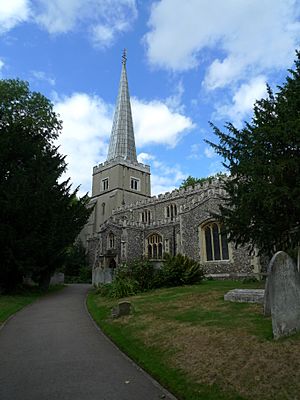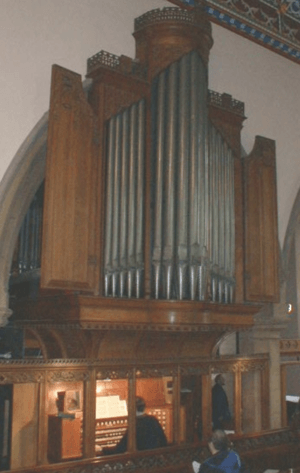St Mary's Church, Harrow on the Hill facts for kids
Quick facts for kids St Mary's Church,Harrow on the Hill |
|
|---|---|

St Mary's Church
|
|
| OS grid reference | TQ 15316 87452 |
| Location | Harrow on the Hill, London, HA1 3HL |
| Country | England |
| Denomination | Church of England |
| Churchmanship | Central churchmanship |
| History | |
| Status | Active |
| Founded | 1087 |
| Founder(s) | Lanfranc |
| Dedication | Blessed Virgin Mary |
| Consecrated | Anselm of Canterbury, 4 January 1094 |
| Architecture | |
| Functional status | Parish church |
| Heritage designation | Grade I listed |
| Architectural type | Church |
| Style | English Gothic |
| Specifications | |
| Number of spires | 1 |
| Materials | sandstone, tiled roof |
| Bells | 10 (Metal Frame 1961, John Taylor & Co. Ltd) |
| Tenor bell weight | 19 - 0 - 4 in E |
| Administration | |
| Parish | Harrow on the Hill |
| Deanery | Harrow |
| Archdeaconry | Archdeaconry of Northolt |
| Episcopal area | Willesden Area |
| Diocese | Diocese of London |
| Province | Province of Canterbury |
St Mary's Church, located in Harrow on the Hill, is a very old and important church in northwest London, England. It's known as the main church for the area and is a special building, listed as Grade I. This means it's historically very important and protected.
A Church with a Long History
Building the First Church
The story of St Mary's Church began a very long time ago, in 1087. A person named Lanfranc, who was the Archbishop of Canterbury, started building a church on this spot. He passed away in 1089. His replacement was St Anselm, who became archbishop in September 1093.
The new church building was finished and named after the Blessed Virgin Mary. St Anselm officially opened it on January 4, 1094. This date was special because, back then, January 6 (Epiphany) was a more important celebration for Christians than Christmas Day.
Changes Over the Centuries
Not much of the first church building from 1094 is still standing, except for the bottom part of the tower. The main part of the church, called the Chancel, with its beautiful arch and tall, narrow windows, was built by the late 1100s. After that, the central part of the church (the nave) was rebuilt, and two side sections (transepts) were added.
Around 1236, the first vicar, John de Holtune, was appointed. This was done by Elias of Dereham, who was also involved in building the famous Salisbury Cathedral.
Special Prayer Chapels
In 1324, two small chapels, called chantries, were created. These were special places where prayers could be said for people who had given money to the church. One chantry was in a chapel about a mile and a half away in Wembley. The second chantry was inside St Mary's Church itself, built over the south porch.
Medieval Improvements
By 1450, many parts of the church had been updated. The upper windows (clerestory windows), the roofs of the nave and transepts, and the top parts of the tower with its famous spire were all built. The roofs of the nave and transepts are considered some of the best in Middlesex, with 377 detailed carvings. The spire is covered with 12 tons of lead!
Victorian Era Renovations
About 400 years later, between 1846 and 1849, the church had a big restoration and renovation. This work was led by George Gilbert Scott. During this time, a low wall (parapet) was added to the roofs, and the north wall of the chancel was taken down to make the building bigger. The east walls were rebuilt, the church was covered with flint stone, and a room for the clergy (vestry) was added on the north side. This vestry was made even larger around 1900.
The Church Organ
In 1893, there was a plan to build an organ on the south side of the chancel. However, this plan changed when three old Norman windows were discovered, still showing their original decorations. Instead, the T.C.Lewis Company was asked to build a large organ, which was finished in 1900. Over the years, the organ has been updated several times to keep it working well.
Ancient Brasses and Memorials
The church has thirteen very old brass plaques, most of which are quite damaged. A special robe, called a cope, was made for the church's 900th anniversary. The designs on this cope were copied from a damaged brass plaque of John Byrkhede, who was a master builder and rector of St Mary's in the 1400s.
There is also a brass plaque for John Lyon, who founded Harrow School, and his wife, Joan. This plaque is on the wall of the nave, near his grave.
Lord Byron's Connection
The famous poet Lord Byron often visited St Mary's Church when he was a schoolboy at Harrow School from 1801 to 1805. He used to sit and dream by his "favourite tombstone" (the "Peachey Tomb"). This is mentioned in his poem "Lines Written beneath an Elm in the Churchyard of Harrow." A memorial in front of the Peachey Tomb, put up in 1905, reminds visitors of Byron's connection.
Lord Byron's daughter, Allegra Byron, is buried in an unmarked grave outside the church, close to the south porch.
Old Features of the Church
The old door that leads into the north porch used to be on the south side of the church. It was moved to its current spot by Gilbert Scott to protect it better. The font, which is a basin used for baptisms, is made of Purbeck marble. The large chest in the north transept, like the door, has been used since at least 1200. The pulpit, where sermons are given, is a beautiful example of woodcarving from the late 1600s and was placed in the church in 1708.
The Church Bells
The tower of St Mary's Church has ten bells. The two smallest bells were made to celebrate Queen Elizabeth II's Silver Jubilee. The oldest bell was made in 1654, and the second oldest in 1683. The other six bells were made in 1960 by John Taylor & Co Ltd.
Location and Views
St Mary's Church is located at the very top of Harrow on the Hill. From the churchyard, you can see amazing views of Central London and many other directions. It is the highest building in Middlesex. You can spot famous buildings like those in Canary Wharf, the BT Tower in Warren Street, and Wembley Stadium.
The church is often seen as a symbol of Harrow and can be seen from many miles away. Since WWI, it has even been used as a landmark for aircraft flying towards RAF Northolt.
Notable Memorials
The church has special memorials to remember important people, including:
- George Butler, a headmaster from 1805–1829
- John William Cunningham (1811–1861), a vicar
- Byron Drury (1815-1888), an admiral
- Joseph Drury, a Head Master from 1785–1805
- James Edwards, a bookseller
- William Gerard, a politician
- John Lyon, who founded Harrow School
- Geoffrey Harold Woolley VC (1944–1952), a vicar
In the north aisle (a side section of the church) are memorials to:
- John Henry North, a politician
- William Osgoode (1754-1824), the first Chief Justice of Upper Canada (which is now Ontario, Canada)
Filming Location
St Mary's Church appears in some early scenes of the 2008 British science fantasy film Franklyn.


